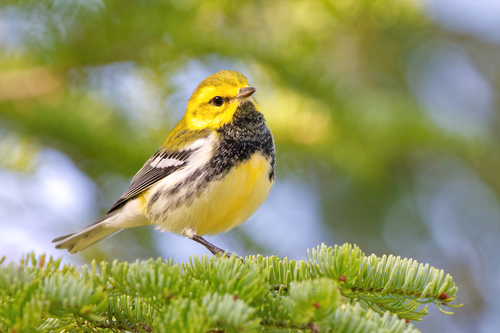
Black-throated Green Warbler
The Black-throated Green Warbler (*Setophaga virens*) is a small, active songbird known for its vibrant olive-green back, bright yellow face, and, in males, a distinctive black throat and bib. This New World warbler plays a crucial role in controlling insect populations within its forest habitat. It is a relatively common and widespread species, often heard singing its characteristic "zee-zee-zee-zoo-zee" song, even if the bird itself remains hidden in the canopy. While not holding specific cultural significance comparable to some other birds, it is a favorite among birdwatchers for its beauty and lively nature.
11-12 cm
Length
17-19 cm
Wingspan
Least Concern
Conservation Status
Distribution
Breeds across eastern North America, from southeastern Canada west to central Alberta and south to the Gulf Coast states and northern Georgia. Winters in Mexico, Central America, the Caribbean, and northern South America. Migrates through the eastern and central United States.
Lifespan
Typically 2-3 years in the wild, up to 7 years recorded.
Black-throated Green Warbler's Habitat
Habitat Types
Mature coniferous forests, Mixed deciduous forests, Swamps
Climate Zones
Temperate, Boreal
Adaptations
Their small size and agility allow them to forage effectively within dense foliage. Their relatively long, pointed wings are adapted for long-distance migration.
Variations
Two subspecies are generally recognized: *S. v. virens* (eastern) and *S. v. waynei* (south-central, coastal plain). *S. v. waynei* is slightly duller in coloration.
Appearance
Breeding Plumage
Males in breeding plumage have a bright black throat and upper breast, bright yellow face, and olive-green back. Females and non-breeding males have a paler yellow or whitish throat, often with some black streaking. Non-breeding plumage is generally duller.
Seasonal Feather Changes
Plumage is brightest during the breeding season (spring and summer).
Sex Based Plumage Differences
Significant. Males have a much more prominent black throat and more vibrant coloration overall.
Notable Features
Bright yellow face and sides of neck, Black throat (prominent in males), Two white wingbars, Olive-green back
Diet and Feeding
Primary Foods
Insects, Spiders, Caterpillars, Berries (occasionally)
Foraging Behavior
Actively gleans insects from leaves and branches, often hovering briefly. Forages at various heights in the forest, from mid-level to the canopy.
Specializations
Their fine, pointed bill is well-suited for picking small insects from foliage.
Seasonal Diet Variations
Primarily insects during the breeding season. May consume more berries and fruits during migration and in winter.
Behavior
Social Structure
Generally solitary or in pairs during the breeding season. May form small flocks during migration and on wintering grounds.
Communication
Distinctive "zee-zee-zee-zoo-zee" song, Chip notes, Flight calls
Migration
Nocturnal migrant. Travels long distances between breeding and wintering grounds.
Territorial or Group Behaviors
Males are highly territorial during the breeding season, defending their territory through song and aggressive displays.
Conservation
Threats
Habitat loss (both breeding and wintering grounds), Pesticide use, Collisions with buildings, Climate change (potential impacts on habitat and insect availability)
Protection Programs
Migratory Bird Treaty Act protection, Habitat conservation efforts in some areas
Local National Laws
Protected under the Migratory Bird Treaty Act in the United States and Canada.
Population Trend
Stable
Population Estimates
Global population estimated at 22 million.
Interesting Facts
They are known for their persistent singing, even on hot days.
This helps them maintain their territory and attract mates even when other birds are less active.
The Black-throated Green Warbler can sometimes be found in mixed-species foraging flocks.
This behavior provides increased protection from predators and improved foraging efficiency.
Wayne's Black-throated Green Warbler is a disjunct population with a small range.
It breeds in southeastern Virginia and northeastern North Carolina.
Faqs about Black-throated Green Warbler
What is the best way to attract Black-throated Green Warblers to my yard?
Providing a source of fresh water and planting native trees and shrubs that attract insects can help. Avoid using pesticides.
How can I tell a male from a female Black-throated Green Warbler?
Males have a much more prominent and solid black throat and bib, while females have a paler throat, often with some black streaking.
Where do Black-throated Green Warblers go in the winter?
They migrate to Mexico, Central America, the Caribbean, and northern South America.
Copyright @ Nature Style Limited. All Rights Reserved.
 English
English